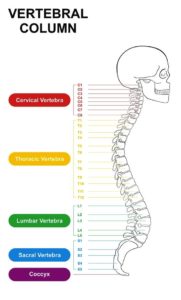Most of the exercises I’ve given you for posture improvement have been generalized, which is to say that most of them did not target a single, specific problem. Instead, they addressed several problems or areas at once.
Today, let’s talk about a general problem, but of a specific area, the thoracic spine.
Thoracic Spine

Your T-spine is the set of vertebrae in the middle and upper back (the parts in yellow above), from below your ribs to above your shoulder blades. This region suffers a couple of problems, the first of which is that the muscles get really tight, and the second is that as we age, it loses all around mobility. As a result, hunchback and tech neck get worse as we get older, and harder to correct.
Now, since the problem is reduced mobility leading to increased hunching, the basic solution is to work in the opposite direction. In other words, thoracic back bends. This area tends to be immobile and tight, so bending it backwards can be difficult. There are lots of exercises for this area, but since this is Yoga for Posture, I offer you two yoga poses; puppy and sphinx.
We did sphinx already, to give a gentle, unloaded back bend. Let’s add a little something for thoracic mobility.
Sphinx Posture:
- Lie face down, palms below your shoulders
- Push your upper body up by straightening your arms
- Lower your elbows to your mat, with your forearms straight forward and move your hands forward until your upper arms are vertical.
- This will put your elbows directly below your shoulders, forearms flat to the mat and pointing straight forward.
- Let your head droop and your shoulders hunch in
- This will release all the tension in your back, butt and legs
- After a few breaths of total relaxation, reposition your arms until your elbows are at 90°
- Raise your eyes to look straight ahead, chin level
- Relax your back and let gravity do the work
Now that you’re in the posture, time to work your T-spine
- Once you have sunk into the posture begin to pull your elbows back
- As you pull back on your elbows, push your chest straight forward
- Concentrate on the area between your shoulder blades, and picture it curving forward.
- Lift your head straight toward the ceiling, or even gently pull your chin in
- This will give you a little extra curvature in your T-spine
Funny enough, we also did Puppy already, to give a gentle traction to the spine. As with Sphinx, we’re going to add a little something for the T-spine
Puppy Posture
- Start from table top (thighs and arms straight up and down, knees bent 90°, spine neutral, neck flat, looking straight down)
- Walk your hands forward, sinking your chest to the floor
- Relax down into it
- Find the most comfortable arrangement of your hips and legs. Experiment with the
- bend in your knees
- distance between your knees
- distance between your feet
- Find the most comfortable arrangement of your arms and shoulders. Experiment with
- Keeping them straight for a shoulder stretch
- Bending at shoulders and elbows to relax deeper
- Find the most comfortable position for your head. Experiment with
- Forehead to the floor
- Chin to the floor (or propped up on your hands
Now you’ve got your most comfortable, relaxing Puppy, and it’s time to bend your spine
- Crawl your fingers forward about a hand span, straightening your elbows and raising your hips
- Plant your hands firmly on the mat
- Pull your hips backwards while pushing your chest toward the floor
- Picture your entire body, from hands to hips, as an archers bow being drawn
- This will cause your T-spine to bend backwards
